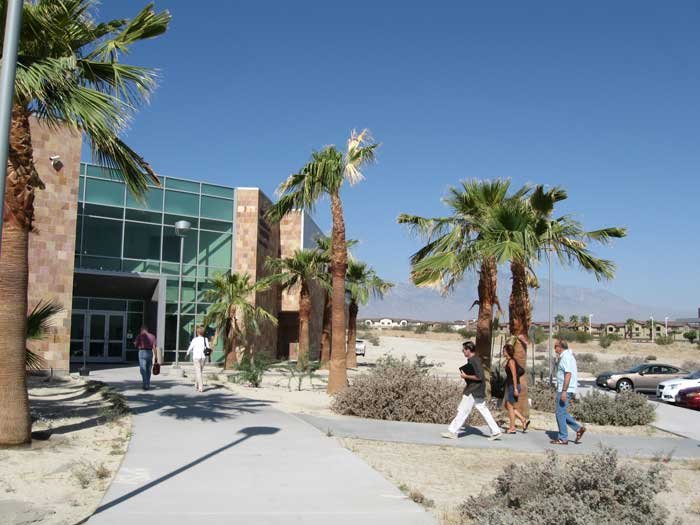Congressional Hearing on Solar Energy Siting: What We're Up Against
May 11, 2009 - Graduate Center of University of California Riverside, Palm Desert, California - By LMC
Send comments to Congress >>here.
About ten global warming protesters holding signs greeted us as we drove up to the building where a "congressional field hearing" was to take place. Young college students and older adults waved and cheered with their wind turbine signs and climate change messages, hoping to sway their representatives to get big polluting energy plants to stop spewing carbon into the atmosphere. A worthy cause, I thought, but I also wondered whether they knew what damage could be done down on Earth, to mountain ranges and desert tortoise flats east of here when big industrial renewable projects moved in.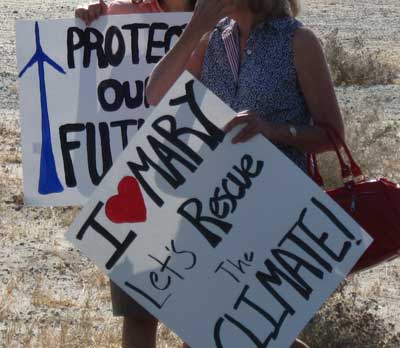
'Solar Energy Development on Federal Lands: The Road to Consensus'
This was the title of the hearing of the U.S. House of Representatives Subcommittee on Energy and Mineral Resources on public lands got underway. Chaired by Rep. Jim Costa (D-Fresno), hosted by Rep. Mary Bono Mack (R-Palm Springs), and also attended by "Big Coal" Rep. Cynthia Lummis (R-Wyoming), the hearing sought to obtain testimony from experts in the solar energy field, including state of California energy specialists, utilities, solar companies, the Bureau of Land Management (BLM), but only one environmental group -- the Sierra Club was allowed to speak. Most of the rest of us barely found out about it in time to get there. The public was not allowed to submit questions for the panel.
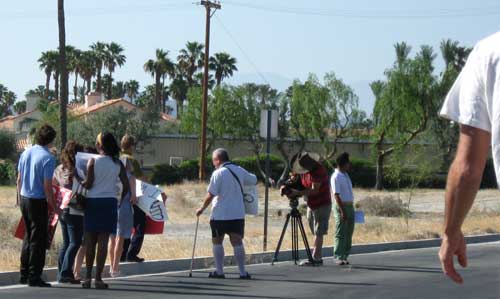
^Protesters for clean energy.
Costa began the hearing by stating that we must develop a road to consensus on siting solar and wind energy on our public lands.
Saying that we must "use all our energy tools in our energy toolbox," to decrease our demand for foreign oil, deal with climate change, and meet the goals of renewable energy in 10 to 20 years. That would include energy conservation and efficiency, rooftop solar, but also traditional sources of energy, "which will still be critical tomorrow." The Congressman was particularly interested in large commercial solar energy plants out on public lands.
The Southwest is "proverbially the Motherload, to take a term from the 19th century," he declared, speaking of utility-scale solar energy. These will all be part of an overall energy effort, he said; "We need a bigger picture in a way that makes economic sense."
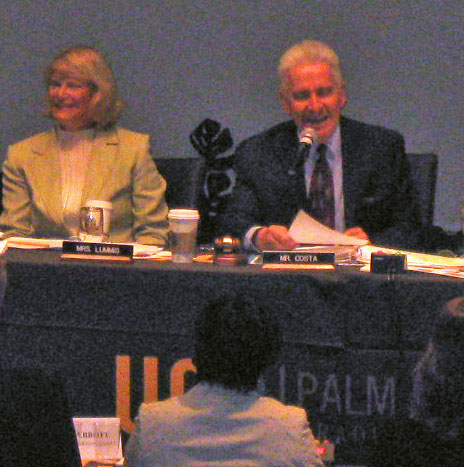 Solar power on federal lands: this was the crux of the debate. How do we use the "vast potential"? Costa admitted utility-scale solar plants can be very "use-intensive" and there will be "mitigation challenges of the footprint," but that multiple use could still be allowed for.
Solar power on federal lands: this was the crux of the debate. How do we use the "vast potential"? Costa admitted utility-scale solar plants can be very "use-intensive" and there will be "mitigation challenges of the footprint," but that multiple use could still be allowed for.
"The last thing we want to do is lock up areas," he pushed, specifically referring to Senator Diane Feinstein's (D-CA) plan to create new national monuments that would block dozens of potential industrial solar projects on the California deserts (see our page on the Route 66 park plan).
"The need is too great" to not use the Mojave Desert for largescale projects, Costa lectured, adding: "Obviously we do not want a land rush..."
Why did I begin to think that the honorable congressman had already made up his mind about where to site big solar plants? The land rush was indeed on.
Rep. Lummis (R-Wyoming) spoke next about how her state was working on how to sequester carbon from coal. She said the country needs nuclear, geothermal, renewables, all for national security. But "like it or not," she wagged primly, we will need "traditional fuel sources well into the next century." Meaning coal, oil, and natural gas.
She reminded the audience that coal forms 50% of U.S. electrical generation. "Clean coal technology" will be developed so coal does not become a "stranded asset" in the future.
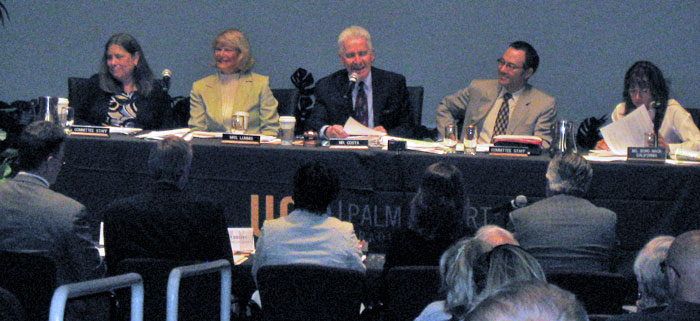
^Rep Cynthia Lummis in yellow, next to Rep. Jim Costa, among congressional aides, and Rep. Mary Bono Mack at the right end.
Congresswoman Mary Bono Mack, from the local area, told the room that "we are consensus builders" in this district. This place is a "natural fit" for solar.
"But keep in mind the unique lands around us," the deserts that bring tourists, new wildernesses, multi-species plans. (We detected a slight sway from local Sierra Club activist Joan Taylor perhaps.) But the "larger goal" she continued, was reducing our "foreign dependency." Bono Mack also explained how we need to move all this rural energy with increased transmission infrastructure such as with the plan called RETI (Renewable Energy Transmission Initiative), the controversial statewide project to site powerline corridors to move remote renewable energy to the cities (often right through rural towns and parks).
She said the committee wanted a "harmonized" approach that "aggressively" seeks to increase renewables and transmission. I noted the word "aggressive" came up a lot with respect to placing solar projects and transmission lines all over our deserts and rural areas, during this hearing. Without "aggressive" action, California will not meet its Renewable Portfolio Standard following the Kyoto Protocol goal of 33% renewables by 2020, Bono Mack said.
A Lone Voice for Local Energy Generation
Palm Desert Councilman Jim Ferguson was the only local leader to address the subcommittee. He discussed the city's groundbreaking energy saving program, including AB811 funding where municipalities give loans to homeowners for rooftop solar, and a test Feed-In Tariff (FIT) program as well (for more see >>here). A Federal FIT program would pay homeowners a fair price for their excess rooftop solar and other green generated capacity.
"Conservation at home" must precede solar development on public lands, he said (we agreed). While saying the local people value renewable energy, Ferguson also pointed out that the regional Coachella Valley Mountains Conservancy and habitat management plans on public lands showed that "we guard our region jealously."
Admitting the need for both rural renewables and residential, Ferguson launched into a quick summary of what the city has accomplished in the local residential energy sector. Distributed generation in the form of rooftop solar panels will result in a 30% reduction in the consumption of natural gas over the next five years. With city loans homeowners get immediate equity, the city gets interest on the loans, and everyone found that saving energy was less expensive than buying dirty energy from out-of-state.
Ferguson said that if all of California conserved 20% on its energy with home solar and conservation practices, this would equal the building of ten new nuclear plants, and the equivalent of drilling in the Arctic National Wildlife Refuge.
Costa's blunt reply was that the councilman had gone over his 5 minutes.
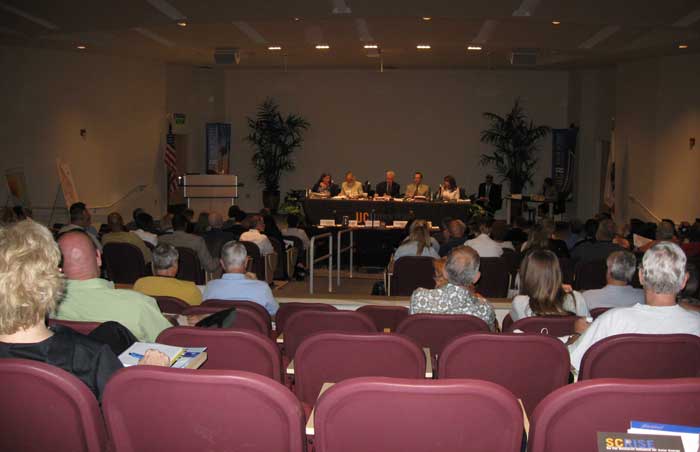
Ferguson's written testimony described a two-phased process to identify "pilot project" areas for siting utility-scale renewable projects on private and federal lands. The first phase would be to quikly find lands that avoid impacting conservation values, prioritizing degraded lands next to load centers, transmission, and exisiting workforce centers. He said there should be no wet-cooled projects in the desert unless they are next to reclaimed water by municipalities.
Phase two would be to develop a long-term comprehensive desert planning process, Ferguson wrote, a "blueprint" that protects rare species, wildlife corridors, climate change adaptation needs, desert lands with carbon sequestration values, ecological process needs, and maintenace of hydrology in arid environments. We agree that it would be good to have a plan like this, but the problem is the horses are out of the gate already and renewable energy companies are racing to meet 2010 deadlines for getting federal grants, as well as buying up precious water rights, and rushing in development plans to government agencies.
But Ferguson ended by strongly advising the subcommittee to first maximize energy efficiency, conservation, and distributed generation (rooftop solar) with a Federal feed-in-tariff to stimulate more activity in this sector. (We agree with this.)
One-Stop Shopping
Next to give testimony was Julia Levin of the California Energy Commission (CEC), the state agency that handles the permitting of thermal power plants (solar thermal, geothermal, natural gas, but not photovoltaic), as well as transmission.
California will get its share of the $40 billion in stimulus money, she began, and we must use "science-based, collaborative, transparent" ways to "expand, expedite, and streamline" renewables and new transmission lines. A "one-stop" permitting process would be most helpful, she explained, a "Desert Renewable Energy and Conservation Plan," in concert with BLM and California Department of Fish and Game.
California Public Utilities Commissioner Rachelle Chong then complained that in 18 years no new solar thermal power plants had been permitted in the state, and that upgrading the transmission grid using the RETI process was "critical" for moving new renewable energy from "wind-rich" lands such as the Tehachapi Mountains (Kern County) to the cities. She told how 90,000 megawatts (MW) of "near-term solar potential" was available in the deserts, mostly on public lands. (At 8.5 acres per MW for solar thermal production, this would require 760,000 acres of land to be scraped to bare dirt.)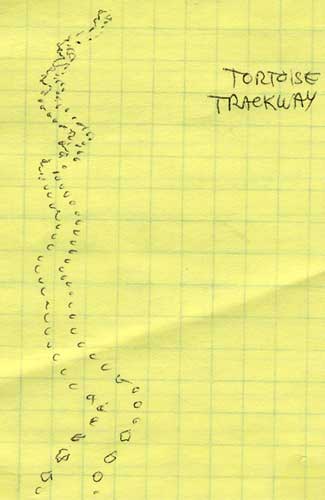
Chong recommended that the committee try to direct federal stimulus money into streamlining the environmental review process. She admitted these utility-scale solar plants have impacts -- water impacts, big footprints. She suggested that the BLM work with environmentalists to lessen the impact on habitats. (How? we wondered.)
BLM Worried
Bureau of Land Management California acting director James Abbott looked a little overwhelmed.
He carefully explained how 33 years after the creation of the California Desert Conservation Area, a zone of special management, new challenges had just arisen, increasing the complexity for BLM.
"There is this rich abundance of solar potential," but with an overlay of ACECS (Areas of Critical Environmental Concern), wilderness, and recreation areas; a wide spectrum of interest groups all had input.
Then the order of March 11, 2009, came down from Interior Secretary Salazar, telling BLM that one of its top priorities would now be renewable energy. Nationally, 158 solar applications were pending on 1.8 million acres of BLM land, totaling 97,000 MW. In California alone 60 solar projects were waiting for their 575,000 acres of public land.
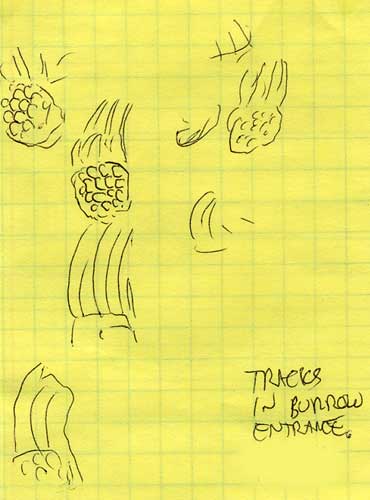
Recognizing the large footprint, these applications needed "special attention," he said. Water issues might be addressed with new technology.
In addition, 6,000 miles of energy transmission lines in eleven western states have been identified, which would be the "backbone" of the renewable energy plan.
"Frankly, we do not have all the answers," Abbott admitted, for a consensus on renewable siting.
"Heightened Security Through Self-Generated Power"
--A logo of the army on a Powerpoint presentation by Thomas Kretzschmar of the U.S. Army Corps of Engineers. He explained how Fort Irwin (a large army base south of Death Valley National Park in the Mojave Desert) is working on its solar energy "enhanced use lease project," where long-term ground leases are given to private commercial renewable projects. Three areas on base were the focus of future projects: at Goldstone the Corps was looking to place photovoltaic fields around NASA's satellite dishes. We note, however, that this area is habitat for the Lane Mountain Milkvetch (Astragalus jaegerianus), a highly localized and rare plant that was listed as endangered under the federal Endangered Species Act in 1997.
Another photovoltaic field could be built on Red Pass Lake dry playa on the eastern end of the base, said Kretzschmar, on 2,000 acres. This spot was "ideal" as it was next to a pre-existing 500 kiloVolt transmission line. We think it is far from ideal, as it is in the area of a recently-identified cryptic species of dune-dwelling Fringe-toed lizard (Uma scoparia), probably a new species. Center for Biological Diversity is in the process of petitioning this species for protection under the federal Endangered Species Act. These are just a few of the examples of the overlay of wildlife and rare plant issues that will be present all over the deserts where solar projects may be sited -- and most areas have not been so well-studied by biologists as Fort Irwin.
 The main gate at Fort Irwin could be the site of a large solar thermal plant, using waste-water available presently at a treatment lagoon, for steam generation, although Kretzschmar pointed out there would be limits to how much such a plant could grow because of water shortages. We noticed that the military seemed slightly more realistsic about the lack of water for so many solar thermal power plants, and were planning mostly photovoltaic panel arrays (but then why not place these on buildings in the cities?).
The main gate at Fort Irwin could be the site of a large solar thermal plant, using waste-water available presently at a treatment lagoon, for steam generation, although Kretzschmar pointed out there would be limits to how much such a plant could grow because of water shortages. We noticed that the military seemed slightly more realistsic about the lack of water for so many solar thermal power plants, and were planning mostly photovoltaic panel arrays (but then why not place these on buildings in the cities?).
Other military installations could become sites of renewable projects as well, Kretzschmar said, such as at the Twentynine Palms Marine base, as well as more than 20 other installations around the southwest. Rep. Lummis had already told us how marvelous her tour of the marine base had been, viewing solar panels added to rooftops that shaded mechanics. Solar panels were even being placed on top of Hummers, as mobile energy-generators.
Fort Irwin currently uses 25 MW of energy, and Kretzschmar explained how any additional energy produced could be sold back to the grid.
Kretzshamar ended his testimony by asking that Congress consider "reducing the lengthy environmental assessment timelines." Permitting takes too long, he complained, to be able to reach the goal of 33% renewables by 2020 in California.
How to Streamline
Rep. Jim Costa asked the panel: "Are we meeting the timelines?"
 Julia Levin of the CEC answered, yes, they would be accelerating permits.
Julia Levin of the CEC answered, yes, they would be accelerating permits.
Councilman Ferguson had left long ago, and Costa quickly asked the remaining panel if we should be using all sources of renewables, rooftop and distributed, but also commercial?
Levin pointed out that distributed is "more expensive" and we can "do so much more quickly and cheaply with utility-scale" renewable projects.
Costa: "Yes," he agreed and looked at Rachelle Chong (Cal. Public Utilities Commission).
Rachelle Chong: "Yes."
Costa nodded his head and looked at Rep. Lummis and Rep. Mary Bono Mack, who had no questions about this, then Costa agreed that utility-scale projects were the only concern here, and asked Abbott of the BLM if competitive leasing would help most to site these big projects. Lummis asked how they identified renewable energy zones on public lands. Both Levin and Abbott gave RETI as a good example. Levin said, "we will look at wildlife and other science-based criteria," then will "accelerate" renewable siting and the least-cost transmission corridors. Chong pointed out how transmission lines usually take seven years to permit, but RETI may take only three years in a "very aggressive" time-frame.
We got the impression that local rooftop initiatives were swept off the table at this point as "too expensive" and the rest of the hearing zeroed in on large projects on public lands, and how to accelerate the permitting process. This ignores, of course, the billions of dollars that will have to be poured into upgrading and constructing new transmission lines to link remote energy projects out in the desert to the cities.
Costa then asked how to "mitigate litigation."
Chong responded that they have reached out to environmental groups to work with them and try to avoid the "most sensitive" areas. (Have they really?)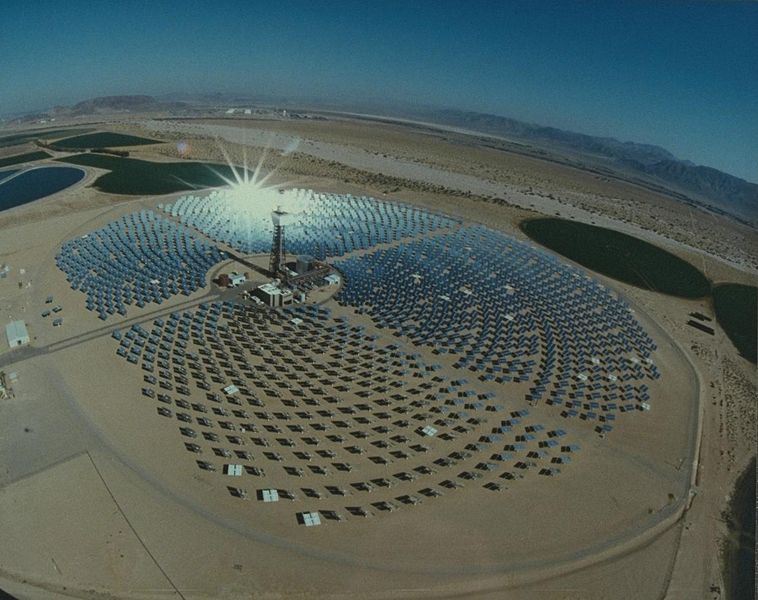
Lummis asked why couldn't more transmission lines be placed along roads? Chong explained how they run into problems with people living along roads where upgrades are scheduled.
Levin requested that more staff be added to the U.S. Fish and Wildlife Service so they could handle the tripling and quadrupling permit load. And could Congress consider changing the laws to help streamline the permit process? (Which laws she was referring to we were not sure.)
Bono Mack seemed slightly skeptical, and asked if we were really going to meet the 2015 goal of 10,000 MW of renewables on public lands? BLM's Abbott said their west-wide study, the Programmatic Environmental Impact Statements (PEIS) for solar, wind, and geothermal will help to expedite permits. She continued, asking if the disturbed lands of the Salton Sea bed, revealed by receding water on the playa, could be looked at for siting projects? Maybe that could solve the dust problem there? Levin said they were pursuing geothermal around Salton Sea.
Lummis asked the panel: wind or solar? Which is better. The unanimous call was for "both," "all" -- "even" rooftop solar, added Chong. "We need every little bit."
Clarity Needed
Steven Malnight, Vice President of Renewable Energy for Pacific Gas and Electric (PG&E), a large California utility, told the subcommittee that the federal government has a vital role in expanding renewable energy. PG&E has 40 plus contracts with renewable companies, and sees solar as especially attractive as providing electricity in peak summer times. One such project is an experimental solar plant planned in Cadiz Valley (San Bernardino County) on lands owned by Cadiz Inc., which will make up to 20,000 acres of land available and provide a reliable groundwater supply for the development of photovoltaic and solar thermal technologies. But new transmission is needed. Federal policies are a must to bring clarity to the process, he stated.
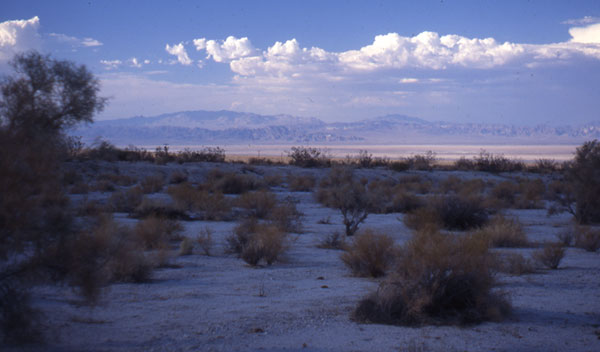
^Cadiz Valley smoke trees, with the Granite Mountains of Mojave National Preserve in the distance.
Sierra Club: Fast-Track Permits on Disturbed Lands
The only environmental group allowed to give testimony, the Sierra Club was represented by Bill Corcoran from Los Angeles (Carl Zichella had been scheduled, but could not attend), and he barely had time to explain the positions of a large body of desert activists and enthusiasts. We had been wary of some of the group's stand on the fence regarding such projects as the Ivanpah solar tower project on pristine desert lands.
The Sierra Club's principles to guide the siting of solar projects included:
1. Disturbed land is preferred.
2. Identify parcels of large disturbed land. But much of private land consists of subdivided areas next to communities, and incentives for small land-owners to sell could be used to aggregate these properties into Enterprise Zones. Tax breaks could be given.
3. Incentives could be given to companies to choose these private disturbed lands. This would make building quicker.
4. Incentives for counties could be introduced for holding land for solar development. Imperial County already has an Enterprise Zone. This way counties could work towards aggregating lands for solar.
5. Generating companies should site projects on disturbed public lands over undisturbed. This would expedite the environmental review process.
Corcoran also recommended the use of less-intrusive technology for transmission, such as undergrounding lines. Staff for government agencies should be increased, including that of the Department of Defense, to make those disturbed lands more available.
Costa, at first making a joke about his eyes glazing over, seemed to accept the recommendations as well thought-out. He told Corcoran that "we may have our differences," but it is good for environmental organizations to make principles.
We were disappointed that the Sierra Club did not talk about urban distributed generation and rooftop solar policies that could be expanded greatly, eliminating the need for remote industrial power plants and giant transmission lines.
Big Solar Speaks: Supersize Transmission!
Katherine Gensler of the Solar Energy Industries Association complained how BLM has not issued solar permits on public lands for years, even though they continue to issue permits for oil and natural gas leases. The audience groaned with an angry "Ohhhhh!" She recommended that the "rent" paid by solar energy companies for public land use go back to fund the new renewable energy offices that BLM will soon be setting up in several states. (Interior Scretary Salazar has already ordered $41 million in stimulus funding be given to BLM to work on the backlog of pending solar and wind permits.) And again -- the environmental review process must be expedited she said. "This does not mean cutting corners," just going faster to get permits by 2010.
CEO of Sempra Energy Utilities, Michael Niggli told how the "world has flipped over." He explained how today it is faster to permit renewable projects than new transmission lines.
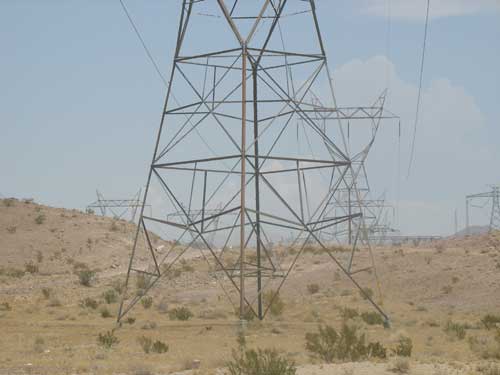 There are too many constraints on permitting -- we need to "supersize transmission," he said. RETI and the Western Renewable Energy Zone Project are good, but "you must make this real," he told the committee. Always "maximize voltage capacity" he recommended. Renewable energy is intermittent, he reminded us, so big transmission lines are needed to move it around. (He failed to mention how exspensive this will be.)
There are too many constraints on permitting -- we need to "supersize transmission," he said. RETI and the Western Renewable Energy Zone Project are good, but "you must make this real," he told the committee. Always "maximize voltage capacity" he recommended. Renewable energy is intermittent, he reminded us, so big transmission lines are needed to move it around. (He failed to mention how exspensive this will be.)
He also discussed the need for renewable energy tradable credits so this energy could be brought to the customer at the lowest cost. (Was utility-scale solar really as "cheap" as Julia Levin assured us, I wondered?) Also, "renewable energy like hydropower and nuclear" should be permitted by court of appeals, he said.
Costa said he had "20 pages" of questions to ask Niggli about his solar company, but had only five minutes (he would send the pages to him for written responses). "Should we support a national RPS (Renewable Portfolio Standard)?" Costa asked. Niggli said they had no problem with that, but emphasized again the need for renewable energy credits or greenhouse gas standards. The PG&E guy said, well, "generally yes."
Costa stated that litigation holds up transmission lines "forever." "We gotta make this work." The Sempra CEO agreed, we have to get the environmental groups to consensus; get the same timelines and deadlines for various agencies in the environmental review process, so companies like his could commit funding.
 Rep Bono Mack asked Sempra if new technology could improve the efficiency of transmission. Niggli explained how the Sunrise Powerlink from Arizona to San Diego carried 580 MW in the 1980s but now it has 1700 MW. Bono Mack asked about new carbon fiber technology? Niggli said this will not give carrying capacity. A 'Smart grid' will work as it helps control the system. Lower-cost underground lines might be a possibility.
Rep Bono Mack asked Sempra if new technology could improve the efficiency of transmission. Niggli explained how the Sunrise Powerlink from Arizona to San Diego carried 580 MW in the 1980s but now it has 1700 MW. Bono Mack asked about new carbon fiber technology? Niggli said this will not give carrying capacity. A 'Smart grid' will work as it helps control the system. Lower-cost underground lines might be a possibility.
The proposed San Diego Gas & Electric (SDG&E) (a utility owned by Sempra) Sunrise Powerlink project is a 123-mile long, $1.9 billion, large transmission line that would be built from the Mexican border in Imperial County deserts to San Diego. Originally it would have been run right through Anza-Borrego State Park until outcry stopped it. But the line is still controversial as it will cut through many towns, communities, and beautiful backcountry mountains and valleys. Theoretically it would carry a certain portion of renewable energy from the deserts, but many critics say the true plan is to deliver dirty fossil fuel from plants owned by Sempra in Mexico. The RETI process was an attempt by the state of California to try to get around such conflicts in the future when placing transmission corridors.
"SDG&E's Sunrise project illustrates the planning and siting problems," Niggli's written testimony stated.
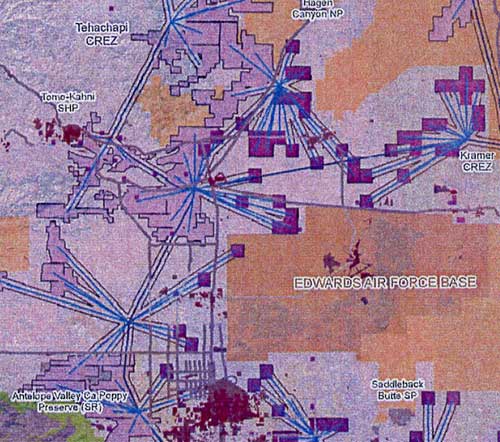
^Part of map showing the RETI transmission lines (blue lines) proposed to connect solar projects (dark purple squares) and wind (light purple) across the west Mojave Desert and Tehachapi Mountains in Kern County, California. The cities of Lancaster and Palmdale lie on the center bottom of the map. This area is also home to Desert Tortoises, Burrowing owls, Kit foxes, Bighorn sheep, and varied Joshua tree and wildflower habitats. (Source: U.S. Energy and Mineral Resources Committee)
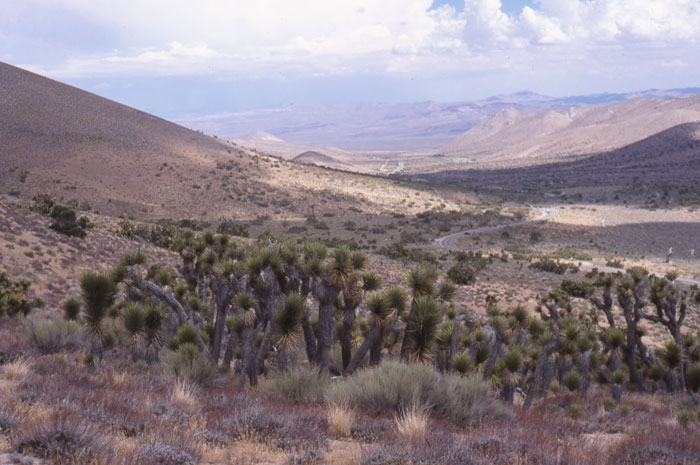
^Joshua trees on the foothills of the Tehachapi Range looking towards the west Mojave Desert. Will this become an industrial renewable energy zone?
A Lead Agency?
All agreed that more agency coordination was needed. Lummis asked if FERC (Federal Energy Regulatory Commission) would be a good lead agency for all future permits? Or a new agency? Costa agreed that the federal government needs o get its own act together, "get grants out," and that FERC or another agency might be chosen to coordinate the process.
Corcoran of the Sierra Club warned the Congressman to be cautious about embedding power in one agency. "A lot of local communities are at stake," he said.
Lummis continued on her quest, asking then why not have the Western Governors Association be the lead agency. Some people in the audience vocally piped up: "No!" Sempra's CEO Niggli reminded the Congresswoman that both state and federal coordination was needed on such complex issues as transmission.
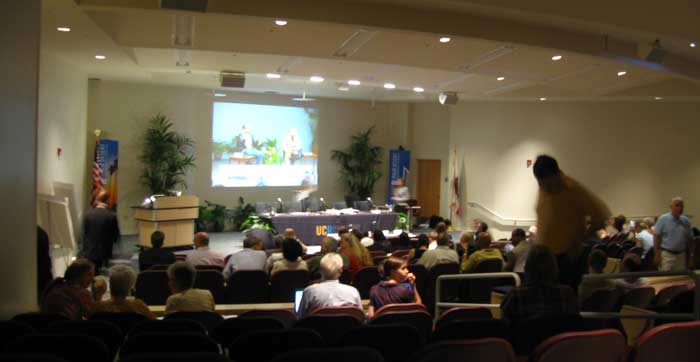
Mitigation
There was talk of The Nature Conservancy's "non-acquisition mitigation" by the solar industry representative, and Lummis, practically drooling coal-carbon, spoke of Wyoming's mitigation funds for conservation leases, leases "not in perpetuity" -- for example, the Pineville Anticline coal development, which is impairing (read: destroying) wildlife corridors. Perhaps these "successful" agreements could be used with solar projects she wondered aloud.
Bono Mack asked if Multi-species plans and Habitat Conservation Plans were good models for mitigation? Sierra Club's Bill Corcoran answered that they were part of the long-term solution. We are skeptical.
Costa Impatient with Sierra Club
Rep. Jim Costa had it out with Bill Corcoran as questions wrapped up, complaining how making new national monuments, such as on Catellus lands, takes away land for renewable energy. Corcoran replied that you could have a monument and still have a "robust renewable portfolio." Can you still have transmission lines, asked Costa? Yes, said Corcoran. (A lot of folks will not be happy to accommodate such new powerlines through their towns, however). Corcoran explained how it is not good to destroy pristine desert. But Costa told him "we need clean renewable energy." "Do other environmental organizations share your view?" he asked. Corcoran said he could not speak for other groups, but admitted that this was "a challenge to our movement." But the Sierra Club has a large amount of conservation knowledge to contribute, he added.
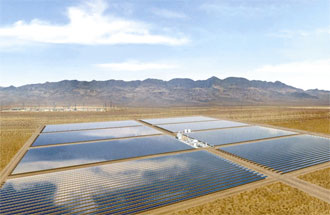 Costa, looking slightly angry, quoted Carl Zichella (Western Renewable Projects Director for the Sierra Club in Sacramento) on how the Sierra Club sought to work with the renewable energy sector. "You have responsibilities," he told Corcoran.
Costa, looking slightly angry, quoted Carl Zichella (Western Renewable Projects Director for the Sierra Club in Sacramento) on how the Sierra Club sought to work with the renewable energy sector. "You have responsibilities," he told Corcoran.
"Yes, there are responsibilities on all sides of the table," Corcoran fired back. He told the committee not to ignore their long history of desert conservation.
Costa ended the questions to him by saying, "but it is public land -- not just for one use." (As if the ecology of a landscape is a single "use" I thought.)
Rep. Bono Mack asked how far along the Sierra Club is in inventorying lands in their Enterpise Zone plan? Corcoran said they could meet the 2020 goals, but it was going to be a "huge challenge" in the short term. He said The Nature Conservancy and Center for Biological Diversity brought a lot of information in to deal with.
Bono Mack said she has hiked with local conservationists, such as Joan Taylor, and wanted to work with them. "People love where they live in this district."

Costa ended the hearing by saying how "elusive" a comprehensible energy policy was going to be, but "we need it" and it must be bipartisan. The findings of this hearing would be taken back to Washington D.C., he said, and he would discuss the issues with his fellow congressmen.
Lose-Lose Situation
We walked out of the building into the hot desert sun, and a local man came up to us saying how he wants to see wind turbines over every mountain around here so he could breath better air quality. I hated to inform him that his elected representatives had no plans to stop using dirty energy like coal and natural gas, and that other folks weren't too happy with having giant wind farms plastered all around their houses.
A woman wanted us to sign a petition for an organization that is trying to get the jobs building the wind turbines in places like Pittsburgh. "All the parts for these windmills are made in Germany or overseas," she said, "not in America." Again, I explained to her that I did not support wind farms at all, sorry...

The kids supporting climate change solutions grabbed the news cameras, demanding more renewables and no more big carbon footprints. Unfortunately the future looks as if we will have all of the above, if Costa can sway his peers. But among renewable choices, the best -- local rooftop solar and other forms of distributed generation -- is getting cut out of the line-up. Good ideas like Florida's Renewable Energy Dividends for rooftop solar were not even mentioned, let alone given a full and fair discussion.
We felt that the hearing failed to recognize the very many concerns that local people in desert communities have about the impacts that large-scale renewable projects will have on their environment, property values, quality of life, and energy bills (who is going to pay for all these new power plants and transmission lines? -- the ratepayers). It appeared as though the meeting was formatted to make approval of these commercial projects very easy for energy developers. We do not feel the United States Congress should be pandering only to the interests of corporate developers. We will be sending letters asking Congress to NOT encourage utility-scale projects anywhere on our desert lands and habitats, but to push legislation for responsible local energy generation (see Alliance for Responsible Energy Policy).
Instead of a well thought-out discussion of better models of future energy policy for the country, with all interested groups and the public at the table, what is happening is a corporate land rush onto our public lands. Right now, our lawmakers are planning ways to help them.
SEND YOUR COMMENTS to CONGRESS
The Desert Protective Council has a great link to send comments to this Congressional committee using CitizenSpeak, telling them to prioritize energy efficiency and local distributed generation (such as rooftop solar) over destruction of our deserts: read the letter and send >>here.
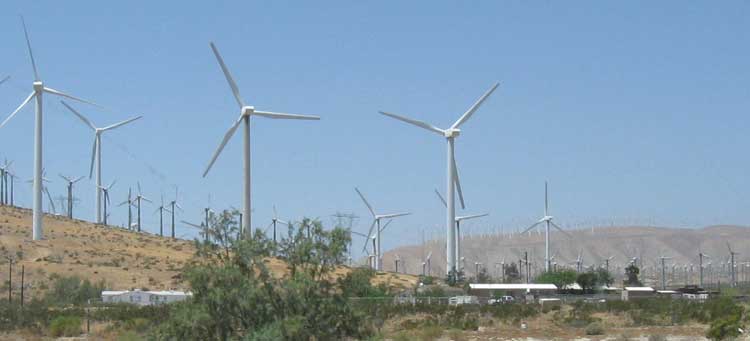
^Commercial? Wind turbines in the Palm Springs area next to houses.

^Or local (yes!): Agua Caliente Band of Cahuilla Indians Reservation at Palm Canyon, where workers are installing solar panels on the roof of the Trading Post.
What's at stake:
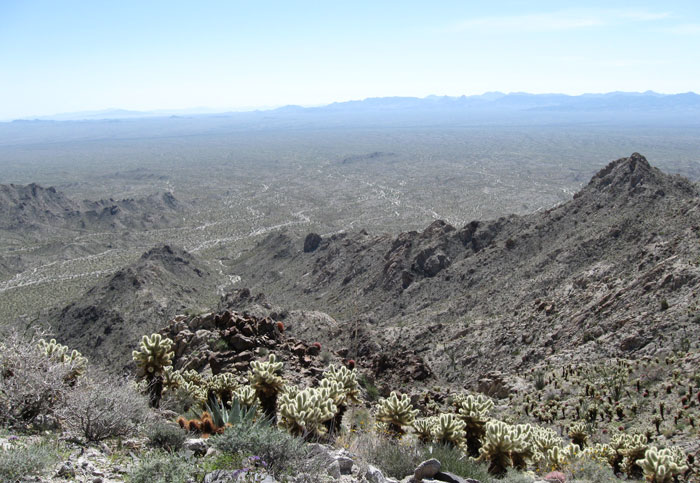
^Colorado Desert in California looking west.

Read the letter to Congress in repsonse to this hearing by The Protect Our Communities Foundation of San Diego, California >>here.
HOME.....Ivanpah Solar Energy Project....Last Spring at Ivanpah?....Sempra Solar Project
Solar One Nevada.....Searchlight Wind Project.....New Comstock Wind Project
Solar in the Desert.....The Problem.....The Solution....AREP-Local Energy Policies
